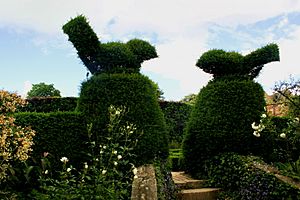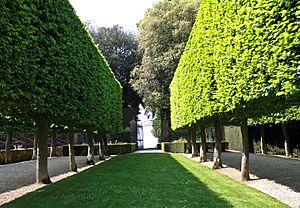Hidcote Manor Garden facts for kids

Hidcote Manor Garden is a famous garden in the United Kingdom. You can find it in the small village of Hidcote Bartrim, close to Chipping Campden in Gloucestershire. It's one of Britain's most well-known gardens, especially for its unique "rooms" made from hedges. These rooms are filled with beautiful plants, rare trees, and colorful flowers. A man named Lawrence Johnston created this amazing garden. Today, the National Trust looks after it, and everyone can visit.
How Hidcote Garden Began
Lawrence Johnston and his mother moved to Britain from America around 1900. Lawrence quickly became a British citizen. In 1907, his mother, Mrs. Gertrude Winthrop, bought the Hidcote Manor Estate. This area was popular with artists and craftspeople at the time.
Lawrence soon became very interested in turning the fields around their house into a garden. By 1910, he had started designing the main parts of the garden. By the 1920s, he had twelve full-time gardeners helping him!
Hidcote Garden became very famous and inspired other garden designers. For example, Phyllis Reiss and her husband bought Tintinhull Garden in 1933. They wanted to create their own garden in the style of Hidcote Manor.
After World War II, Lawrence Johnston spent more time at his other garden in France. In 1947, he gave Hidcote Garden to the National Trust. This meant the garden would be protected and open for everyone to enjoy. Even today, Hidcote's style inspires new gardens, like one shown at the Chelsea Flower Show in London in 2007.
Exploring Hidcote's Garden Rooms
Lawrence Johnston got ideas for Hidcote from other garden designers like Alfred Parsons and Gertrude Jekyll. They believed in creating gardens with different "outdoor rooms." Hidcote Garden is famous for these rooms. They are made using hedges of box, hornbeam, and yew trees, along with stone walls.
Each garden room at Hidcote has its own special feel and theme. For example, there's a 'White Garden' where all the flowers are white, and a 'Fuchsia Garden' filled with fuchsia plants. These rooms are connected by paths and sometimes by views through the hedges. Many rooms have topiary (plants shaped like animals or objects), ponds, and fountains. They are all planted with beautiful flowers. The garden surrounds a manor house from the 1600s and also has a kitchen garden where food was grown.
Lawrence Johnston was very careful about choosing the best plants. Some plants even have "Hidcote" in their name because they were first grown or made famous here. These include the narrow-leaved lavender called 'Lavandula angustifolia 'Hidcote, the pink flower 'Penstemon 'Hidcote Pink, and the yellow shrub 'Hypericum 'Hidcote Gold.
Images for kids




